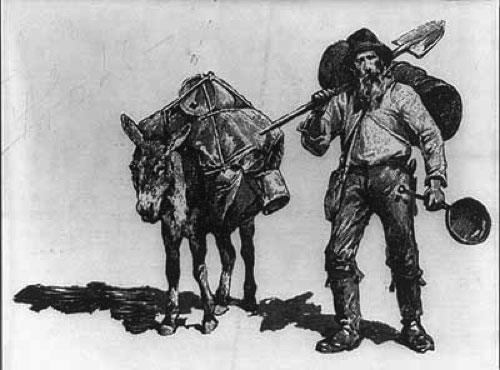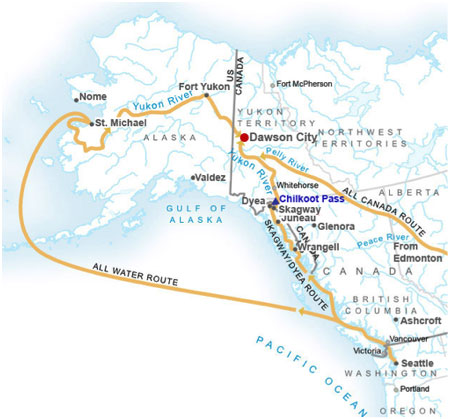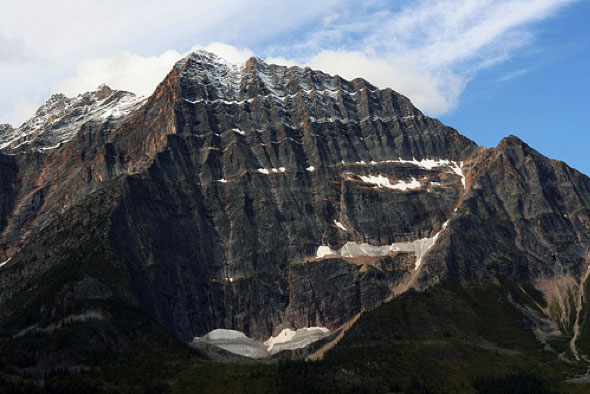Teaching the Gold Rush One facet of Alaskan lore that folks never tire hearing about is the Yukon Gold Rush. And why not? Everyone dreams of striking it rich, and some people did just that here on Yukon soil. Of course, it also spurs a lot of questions. Who were these men who gave up everything to take a chance on prospecting? How’d they even get up here? Was it worth it?
Your Next Adventure Starts Here
Search open jobs-
Here in Alaska, we love telling their story. If you come up and join us for a summer, we can guarantee you that people will ask you about the gold rush, too. Following are the answers to some of those questions and the story of the die-hard prospectors who risked their lives to strike it rich in the frigid Yukon.
-
The Rush Begins
Gold was discovered in the Yukon in 1896 by local prospector George Carmack and his family, who measured out four claims of land to mine along present-day Bonanza Creek. He registered for the land that August, and by the end of the same month, all land along the creek had been claimed by local miners.
As news spread, prospectors began searching upstream for their prize. More gold was discovered in another creek, later called Eldorado, which fed into Bonanza. Over the winter, local prospectors worked feverishly, mining the gold beds, but the ice was too thick on the rivers to send the gold to Seattle or San Francisco to sell. In the Spring of 1897, the ice melted and the gold was sent down to the port cities, and news traveled fast, inspiring a stampede of brave souls made the trek up north to get their share.
Although very few of the non-local prospectors struck gold, many stopped along the way to help build towns and livelihoods along the way. Skagway, Dawson City, and many other port towns experienced an economic boom as their populations increased dramatically.
-
What were the chances of striking gold?
The men who came to Alaska and the Yukon between 1897 and 1899 searching for gold were incredibly courageous, taking fate into their own hands. Few people would have the guts or stamina to travel hundreds of miles over frozen mountain passes and through swamps to get to the Yukon wilderness, all for a chance of striking gold.
Out of the 100,000 prospectors who ventured north, only about 30,000 to 40,000 made it to Dawson City. And of those who made it, only 4,000 prospectors were lucky enough to find gold. A lot more were left with nothing. In all, only 4% of prospectors who left home actually struck gold. While they’re not the worst odds, seems like there must have been easier ways to strike it rich.
-

This photo by the Smithsonian Science Education Center is used under a Creative Commons license Don’t leave home without it: Packing for the trip
When prospectors planned their trip to Dawson, they had to know exactly what they’d need to bring with them to survive the rough terrain and stay healthy. To ensure the safety of prospectors, all border crossings between the U.S. and Canada held a required list of supplies for each prospector, which included everything from a hatchet to flour, from bacon to rubber boots. The list was designed to sustain the travelers for one year. If they failed to carry all necessary tools, the prospectors would not be allowed into the neighboring country.
When weighed, the items on the must-bring list averaged a weight of one ton. That’s 2,000 pounds, or the equivalent of the size of a full-grown American bison! Traveling under this sheer amount of bulk was difficult to say the least, and prospectors needed a mule, oxen, or a team of sled dogs to help carry the weight.
For the prospectors who couldn’t afford pack animals—or didn’t want to drag along the extra supplies the animals required—the only option was to carry all that gear the whole way. Because one person cannot carry 2,000 lbs on their back, each prospector had to move his gear in 65-lb increments on their back, taking 30 trips to haul all their gear. This, of course, greatly increased the amount of time it took for these prospectors to achieve their goal and made the trip much more arduous. But there were gold in those hills and these were some determined gold hunters!
-

National Park Service is used under a Creative Commons license Getting There: Three Paths to Gold
In order to reach the gold, prospectors had to plan their trip carefully. Many people took the Skagway/Dyea Route, starting from Seattle and traveled up through British Columbia and into southern Alaska before reaching the Yukon River, which they followed to Dawson. Other prospectors attempted to avoid the uneven terrain and bitter climbs, opting for the All Water Route, which led sailors around the coast of Alaska and upriver to Fort Yukon. From there, they had to cross into the Yukon Territory on foot.
Both of these routes looked easier on a map than the All Canada Route, but both crossed the U.S./Canada border multiple times. For those who wanted to avoid the regulations of border patrol, the All Canada Route was their best bet.
-

This photo by Pascal is used under Creative Commons License The All Canada Route
Many members of the British Empire utilized the All Canada Route to avoid U.S. customs. However, the 540-mile trek from Ashcroft, BC to Glenora, AB was a treacherous beginning to the journey, crossing swamps, river gorges, and mountain passes through present-day Jasper National Park. Once in Glenora, many prospectors replenished their supplies and formed groups to support each other in the 1,533-mile journey North to Dawson City.
Avoiding the American borders certainly had its drawbacks, as the All Canada Route was incredibly difficult and hard to follow. There was no set trail leading to Dawson, and many groups attempted the journey from different directions. Remember that many prospectors had to make each leg of their trip 30 times with about 65 lbs of gear on their backs, and much of the terrain was covered in swamps and craggy mountain passes.
For those that did use pack animals, the harsh conditions of Canada proved too difficult and most animals died along the way. The journey to Dawson City was so difficult that many prospectors gave up and many others perished just trying to get there. All for a 4% chance of striking gold!
-
6 Easy Gold Rush Facts to Share With Guests
When you are asked about the Klondike Gold Rush (also called the Alaska Gold Rush), be sure to keep the following facts in your pocket:
- Every prospector had to carry about one ton (2,000 lbs) of supplies up to Dawson City.
- Many prospectors used pack animals, who were not strong enough to make the trip and many perished.
- Other prospectors carried the load on their back, which required 30 trips to travel any distance.
- The All Canada route was the only one that didn’t require border crossings, so prospectors didn’t have to prove they had all required gear.
- The All Canada route was extremely difficult, and only one out of three people made the trek all the way to Dawson City.
Want to learn more? Next month we’ll follow up with information on the “All Water Route” to Dawson City, also called the “Rich Man’s Route.” We hope you enjoyed this learning experience! Do you have a favorite Klondike Gold Rush story you like to share? Let us know in the comments below.

